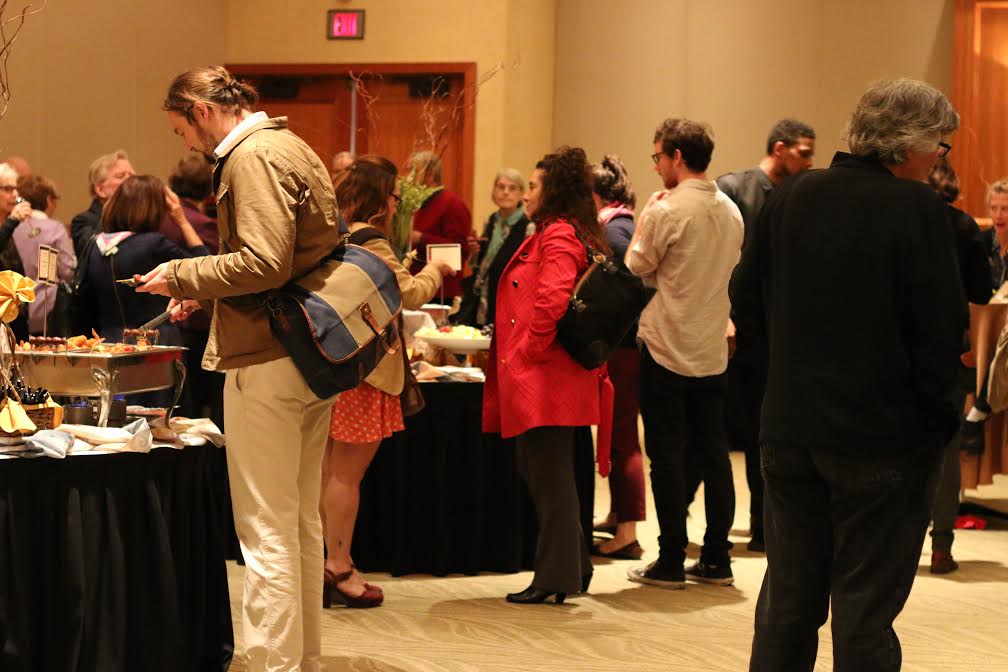
The ways we understand disability informs much of what know, although we do not realize it, according to Katherine Ott, Curator of the Division of Medicine and Science for the National Museum of American History at the Smithsonian Institution. Her work strives to push people to rethink assumptions and reframe their perceptions.
Ott was the guest speaker for the seventeenth, and final, annual Fredric M. Miller Memorial Lecture on Friday, April 10. Her lecture, “Different Bodies/Hidden Histories,” delved into ideas of disabilities, race, and material culture. The lecture culminated two days of events at Rutgers University-Camden that included the annual OHMAR (Oral History in the Mid-Atlantic Region) Conference and the Telling Untold Histories Unconference.
The lecture is named for Miller (1947-1998), an archivist, historian, author, and curator of the Urban Archives Center at Temple University from 1973 to 1989. From 1989 to 1998, he served as a Program Officer for the National Endowment for the Humanities. Miller’s work also included the co-authored Still Philadelphia and Philadelphia Stories and the authoritative Arranging and Describing Archives and Manuscripts, published by the Society of American Archivists in 1990.

Ott earned her Ph.D. at Temple University, where she studied the history of medicine and was once a student in Miller’s archives course. “I remember Fred explaining what the term ‘material culture’ meant, one evening early in the semester,” Ott explained. “It was a new term for me and I wrote it down. … I could not for the life of me understand why a fancy, obscure term was necessary when I had been using words like ‘stuff’ and ‘crap’ quite successfully for most of my life,” she added, humorously.
“I think his openness and lack of elitism allowed me to imagine myself being capable of working in public history with material culture,” she continued. “He certainly made archives and special collections friendlier and approachable which was huge for me, as an intimidated but intellectually ravenous student. Fred’s openness allowed me to realize myself. I am continually grateful to him for that.”
Ott began her career at the Smithsonian about seventeen years ago—the same year the first Miller Lecture took place. Like many in the world of public history, Ott did not anticipate her career in this field. “I sort of backed into it,” she recalled during an interview prior to her lecture. “I was teaching and focused on a conventional academic career and got a post-doc fellowship at the Smithsonian. Being forced to think about artifacts—they were all around me—made me start to understand how much of the historical record I was missing out on.”
At the National Museum of American History, Ott’s work includes documenting, researching, and interpreting medicine and health, disability, and LGBTQ history. She is the author of Fevered Lives: Tuberculosis in American Culture since 1870 and the co-editor of Artificial Parts, Practical Lives: Modern Histories of Prosthetics and Scrapbooks in American Life. Also, she co-edited a special issue of The Public Historian that explored the connection of disability studies and public history—the topic of her address.

Ott demonstrated ways of understanding “hidden histories” of the body through close examination of material culture, especially technology. “Technology is used to place people in hierarchies, and tools are all we have of marginalized people and experiences, such as people who cannot write,” she said. Using the example of a migrant farm worker’s hoe, she noted that it is a tool used by farmers all over the world. The tool makes it possible for farmers to work close to the soil. Over time, however, both the hoe and the farmer’s physical body may break down because of all the work they endure.
When one pictures a disabled person, an image of a wheelchair or crutches may first appear in their mind. Challenging traditional interpretation, Ott said that she was saddened by downgrading views of crutches.

“We need to reclaim the concept of crutches,” she stated. She encouraged thinking of crutches as supportive technology, not a debilitating tool. For example, a cherry-picker construction crane might be seen as a crutch, even though it is used by able-bodied workers to lift their bodies to high elevations. Much like crutches, the cranes support the whole body and allow people to achieve success.
“Aesthetics of disability and our assumptions are everywhere,” Ott pointed out. For example, she called attention to stereotypes of race and disability that persist within American culture by showing a picture of a wind-up toy representing a Mexican as a cactus wearing black sunglasses, a large sombrero, and a gun around its waist. As the toy illustrated, stereotypes are perpetuated by embellishment and misrepresentation.

In discussion with the audience, Ott said that museums could convey interpretations of “hidden histories” by using docents and connecting visitors with research materials before and after their visits. A wide range of platforms, including social media, can be used to promote interacting, thinking, and learning.
Asked what speaking at the final Miller Lecture meant to her, Ott said she knows Miller’s approach to the public history world will not fade. “I may be the last in this lecture series, but I know that I am not the last of Fred’s students to carry forward his curiosity and compassion and willingness to stick his neck out and take intellectual risks. There are a bunch of us.”
Naomi Miller, Fred’s widow, closed the evening by thanking the audience. “I want to thank everyone for the past seventeen years for remembering Fred with me,” she said. “I’ve certainly learned a lot. It’s been a wonderful way to honor Fred. It would have made him proud.”
And with that brief, but meaningful, conclusion, seventeen years of remembrance, reflection, and celebration came to a close.

